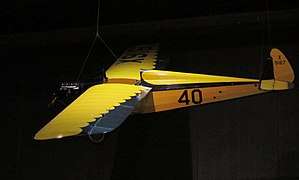Church Midwing JC-1
The Church Midwing JC-1, a.k.a. Church Mid-Wing Sport,[1] is a midwing racing aircraft designed by James Church using the fuselage of a Heath aircraft.
| Church Midwing JC-1 | |
|---|---|
 | |
| A Church Midwing on display | |
| Role | Racing aircraft |
| National origin | United States of America |
| Manufacturer | Church Airplane & Mfg Co |
| Designer | James Church |
| First flight | 1928 |
| Program cost | $890 in 1928 |
| Developed from | Heath Parasol |
Design and development
The Church Midwing was designed to be an affordable homebuilt aircraft. Church marketed kits for $190.
The open cockpit midwing aircraft featured windows in the wings for visibility downward.[2]
Operational history
Built to be a pylon racer, a Church Midwing placed third in the 1930 National Air Races. The Church used many parts from the Heath Parasol design. In 1931 the prototype was modified with an installation of a 38 hp inline air-cooled Church designed engine and a cowling modification to accommodate the cylinders protruding upward in the pilot's line of sight.[3] A 1931 advertisement placed by Heath in Popular Mechanics extolled the virtues of its first-place finish with its parasol configuration, compared to the Church's midwing planform.[4]
Variants
- RW4 RagWing Midwing Sport Replica
- An ultralight replica of the JC-1, produced by RagWing Aircraft Designs.[5]
- Church Racer[1]
- Essentially a Midwing fitted with a model J-3 46hp Church Marathon engine.[6]
Aircraft on Display
- EAA AirVenture Museum, Oshkosh, Wisconsin - 1[7] A Basket case 5 year restoration completed in 1971 by Gene Chase, outfitted with a Heath-Henderson B-4 engine.[8]
Specifications (Church Midwing JC-1)
Data from EAA
General characteristics
- Length: 16 ft 9 in (5.11 m)
- Wingspan: 26 ft 8 in (8.13 m)
- Wing area: 110 sq ft (10 m2)
- Empty weight: 367 lb (166 kg)
- Gross weight: 584 lb (265 kg)
- Fuel capacity: 4.5 Gal (17 litres)
- Powerplant: 1 × Heath-Henderson B-4 Inline 4 cylnder, 27 hp (20 kW)
Performance
- Maximum speed: 78 kn (90 mph, 140 km/h)
- Cruise speed: 61 kn (70 mph, 110 km/h)
- Stall speed: 24 kn (28 mph, 45 km/h)
References
- "American airplanes: Ca - Ci". Aerofiles.com. 2008-08-15. Retrieved 2011-01-28.
- Jay P. Spenser, National Air and Space Museum. Aeronca C-2: the story of the flying bathtub.
- Popular Aviation: 43. July 1931. Missing or empty
|title=(help) - Popular Mechanics. January 1931. Missing or empty
|title=(help) - "RW4 RagWing Midwing Sport Replica". Retrieved 4 April 2011.
- Popular Aviation: 133. August 1932. Missing or empty
|title=(help) - "Church Midwing". Archived from the original on 19 July 2011. Retrieved 2 April 2011.
- Air Trails: 22. December 1971. Missing or empty
|title=(help)